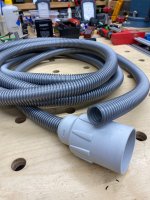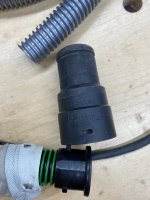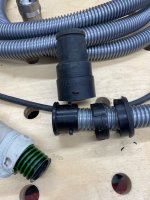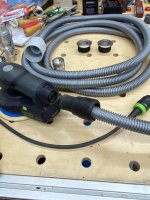New to the Festool ETS EC sander line, and while everything about them is very nice - I noticed it is very back heavy. Add in the plug-it cable and a dust hose and it's heavy enough that after 20 minutes of sanding my forearm/wrist is on fire. Just curious if this is something that is common among users here? Will I get used to it?, is their a better technique to hold it for longer periods that i'm missing? Any insight would be great.
You are using an out of date browser. It may not display this or other websites correctly.
You should upgrade or use an alternative browser.
You should upgrade or use an alternative browser.
ETS EC sander balance
- Thread starter gaf
- Start date
luvmytoolz
Member
Are you sanding overhead or vertically?
I've been using Festool sanders over 40 yers now and the ETC EC's are the lightest and easiest to manage I've found. I do flat sanding for hours at a time mainly so I just let it glide over the surface with a light control guiding it. I've seen others mention maybe you need to turn the extractor down a little so you're not fighting the suction?
I've been using Festool sanders over 40 yers now and the ETC EC's are the lightest and easiest to manage I've found. I do flat sanding for hours at a time mainly so I just let it glide over the surface with a light control guiding it. I've seen others mention maybe you need to turn the extractor down a little so you're not fighting the suction?
I don't have an EC version but they do seem like they would be back heavy and need to be held to remain flat. The non EC ETS150 does not. On large surfaces you can guide with one or two fingers much of the time.
Seth
Seth
luvmytoolz said:Are you sanding overhead or vertically?
I've been using Festool sanders over 40 yers now and the ETC EC's are the lightest and easiest to manage I've found. I do flat sanding for hours at a time mainly so I just let it glide over the surface with a light control guiding it. I've seen others mention maybe you need to turn the extractor down a little so you're not fighting the suction?
Just sanding flat at the workbench. I think the hose is doing a really good job tugging is down at the back and causing the pain. Dont' think suction is of issue as it glides very smoothly, just wants to tip up constantly.
Michael Kellough
Member
I use two hands. With one hand lift the hose/cord enough that the sander sits flat on the work surface and then a couple fingers from the other hand are enough to guide the sander. Just keep both hands moving the same direction simultaneously and it’s easy.
Cheese
Member
It kind of really depends upon which vacuum hose you're using. For sanding applications with the ETS EC, I use the 22/27 covered hose which is a very light hose because it varies in diameter from 22 mm to 27 mm.
I've often wondered why someone didn't adapt the super light weight 21.5 mm hose, typically used on the HSK sanding block for use on Festool sanders, as they really don't need a lot of CFM for effective dust removal. These ETS EC sanders are removing, volume wise, very small amounts of sanding debris. Certainly within the capabilities of the HSK hose.
I've often wondered why someone didn't adapt the super light weight 21.5 mm hose, typically used on the HSK sanding block for use on Festool sanders, as they really don't need a lot of CFM for effective dust removal. These ETS EC sanders are removing, volume wise, very small amounts of sanding debris. Certainly within the capabilities of the HSK hose.
luvmytoolz
Member
Great idea Cheese! A thinner hose would be much better for the ETS EC's. I might look at cobbling something together like that myself.
mino
Member
gaf said:Just sanding flat at the workbench. I think the hose is doing a really good job tugging is down at the back and causing the pain. Dont' think suction is of issue as it glides very smoothly, just wants to tip up constantly.luvmytoolz said:Are you sanding overhead or vertically?
I've been using Festool sanders over 40 yers now and the ETC EC's are the lightest and easiest to manage I've found. I do flat sanding for hours at a time mainly so I just let it glide over the surface with a light control guiding it. I've seen others mention maybe you need to turn the extractor down a little so you're not fighting the suction?
This may not help specifically, but outside using a boom arm what I do /with any light sander/ is two things:
a) for one-hand operation, I wrap my hand around the hose - that way the hose is not only not in the way, it also is auto-magically supported
b) as mentioned above, use the second hand to hold the hose above the workbench a bit - not firmly, just loosely-enough
As for the comments of the heavier sanders "just floating around". That is true, up to a point though. Even with the RS 200 one does not really want to allow the hose to weight the sander to the back. It does cuase uneven sanding even with a monster sander it is.
The reason why the EC sanders -seem- back-heavy is that they are soo light. Being so light, the effect of the hose weight is much more pronounced relatively.
That said, while the ETS 150 or the RS 200 series are just gems to work with horizontally, that is just about the only position they are comfortable at. The weight helps with stability there for sure but hurts everywhere else. I once used my RS 200 on an OSB wall, and it was not a pleasant experience.
For everything else, the EC series low weight is just priceless. It does require a bit of a different technique though. Using it habitually like one would use a "heavy" style sander - e.g. the ETS 150 - will just not work.
rvieceli
Member
[member=81927]gaf[/member] The ETS EC sanders are great sanders but they do need help to stay flat on a surface.
A couple of more things for you to try. In the shop I have a screw eye/hook in the ceiling on my side of the sanding station. I hook the hose to that point with a bungee cord. Give enough slack to move the sander adequately. That helps.
If you are not able to do that or need more movement, try placing the hose over the shoulder that the sander is on.
adjust the slack so the hose just lays on your arm.
if the hose keeps falling off your shoulder, loop the hose over your shoulder behind your neck and over the other shoulder and then under your arm.
It doesn't require a LOT of pressure to keep the sander that. But if you are worried about it you may jus be pressing down a bunch and have a death grip on the sander, Relax your han and apply just enough pressure to keep it from tipping. It may reduce the stress on your wrist.
Ron
A couple of more things for you to try. In the shop I have a screw eye/hook in the ceiling on my side of the sanding station. I hook the hose to that point with a bungee cord. Give enough slack to move the sander adequately. That helps.
If you are not able to do that or need more movement, try placing the hose over the shoulder that the sander is on.
adjust the slack so the hose just lays on your arm.
if the hose keeps falling off your shoulder, loop the hose over your shoulder behind your neck and over the other shoulder and then under your arm.
It doesn't require a LOT of pressure to keep the sander that. But if you are worried about it you may jus be pressing down a bunch and have a death grip on the sander, Relax your han and apply just enough pressure to keep it from tipping. It may reduce the stress on your wrist.
Ron
Vondawg
Member
I have done just what Cheese-has mentioned…on a L shaped 40 ft. Bar that needed lots of sanding rough and between coats …worked great except I kept stepping on it
But it gave better flexibility to move around
But it gave better flexibility to move around
Crazyraceguy
Member
- Joined
- Oct 16, 2015
- Messages
- 5,548
I generally do the 2 hands method too, unless I'm working on a vertical surface. It's mostly the hose dragging you down. If you keep it supported, it will be much easier on the sanding hand.
At a Festool event years ago a German woman from the Festool team showed me a trick and it’s basically what Mino described. Put your right arm under the vac hose before grabbing the back ends the sander. By doing this it causes the hose to wrap around your arm and support the back of the sander preventing it from heeling. It takes a little getting used to but I think that this will help you a great deal!
SRSemenza said:I don't have an EC version but they do seem like they would be back heavy and need to be held to remain flat. The non EC ETS150 does not. On large surfaces you can guide with one or two fingers much of the time.
Seth
Yeah because they added more stuff to the rear while removing even more from the center, resulting in the center of gravity moving to the rear.
In some cases a bigger weight is easier to hold if it moves the center of gravity in the right direction. Like with dSRL cameras. My Nikon D300 / D810 become way more heavier when adding the grip (~ +400 grams) but with it the pinky finger fits on it too and especially when paired with a front-heavy telephoto lens the center of gravy moves rearward, reducing the required torque on your wrist to hold it, even though arm muscles have to hold more weight.
mino said:gaf said:Just sanding flat at the workbench. I think the hose is doing a really good job tugging is down at the back and causing the pain. Dont' think suction is of issue as it glides very smoothly, just wants to tip up constantly.luvmytoolz said:Are you sanding overhead or vertically?
I've been using Festool sanders over 40 yers now and the ETC EC's are the lightest and easiest to manage I've found. I do flat sanding for hours at a time mainly so I just let it glide over the surface with a light control guiding it. I've seen others mention maybe you need to turn the extractor down a little so you're not fighting the suction?
This may not help specifically, but outside using a boom arm what I do /with any light sander/ is two things:
a) for one-hand operation, I wrap my hand around the hose - that way the hose is not only not in the way, it also is auto-magically supported
b) as mentioned above, use the second hand to hold the hose above the workbench a bit - not firmly, just loosely-enough
As for the comments of the heavier sanders "just floating around". That is true, up to a point though. Even with the RS 200 one does not really want to allow the hose to weight the sander to the back. It does cuase uneven sanding even with a monster sander it is.
The reason why the EC sanders -seem- back-heavy is that they are soo light. Being so light, the effect of the hose weight is much more pronounced relatively.
That said, while the ETS 150 or the RS 200 series are just gems to work with horizontally, that is just about the only position they are comfortable at. The weight helps with stability there for sure but hurts everywhere else. I once used my RS 200 on an OSB wall, and it was not a pleasant experience.
For everything else, the EC series low weight is just priceless. It does require a bit of a different technique though. Using it habitually like one would use a "heavy" style sander - e.g. the ETS 150 - will just not work.
As a bit on context i'm coming from the standard issue Dewalt sander. For all it's shortcomings, it sits completely flat/upright on it's own - so I guess a long while of being used to that is what's throwing me off the Festool. Wrapping my arm/hand round the hose is a bit awkward, but even after a quick test i can see it takes alot of weight off the back.
Thanks everyone for the suggestions, i'll try everything and see what works best.
Cheese
Member
Well, [member=75933]luvmytoolz[/member] so this is what happens as you get old. I forgot completely about this little experiment.luvmytoolz said:Great idea Cheese! A thinner hose would be much better for the ETS EC's. I might look at cobbling something together like that myself.
No need to cobble something together as the Festool parts already exist. [big grin]
It's pretty straight forward, taking a stock 21.5 Festool HSK hose and adding some standard components from the Festool 22/27 covered hose to produce a super light weight and flexible hose specifically for sanding tasks.
[attachimg=1]
[attachimg=2]
[attachimg=3]
[attachimg=4]
[attachimg=5]
[attachimg=6]
[attachimg=7]
Attachments
luvmytoolz
Member
Thanks for that Cheese! Lots of good info there!
Similar threads
- Replies
- 15
- Views
- 2K







